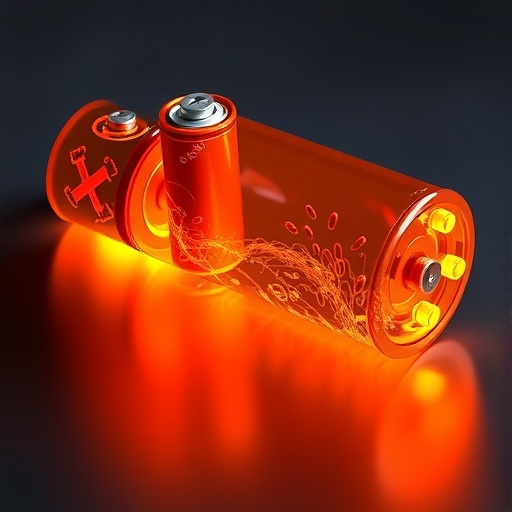The ever-increasing demand for advanced energy storage solutions has prompted researchers to explore novel materials for lithium-ion batteries, which are crucial for a wide range of applications including electric vehicles and portable electronics. One of the recent advancements in this field involves the development of a composite cathode material that integrates lithium fluoride (LiF) with vanadium dioxide (V2O3). This innovative approach aims to enhance the electrochemical performance of lithium-ion batteries, addressing the pressing need for improved energy density and cycle stability.
The research undertaken by Ning, Sui, Tang, and their colleagues delves into the preparation and characterization of the LiF-V2O3 composite cathode. Their findings suggest that the proposed composite material could significantly outperform traditional cathodes in terms of capacity and longevity. By combining these two components, the researchers aim to harness the unique properties of both materials, which may lead to breakthroughs in battery longevity and efficiency.
One of the standout features of LiF is its excellent ionic conductivity, which is vital for enabling efficient lithium ion transport during the battery’s charge and discharge cycles. This property is especially important as it directly correlates with the overall performance of lithium-ion batteries. By enhancing the ionic transport pathways through the incorporation of LiF, the researchers have strategically addressed one of the common bottlenecks in traditional cathode materials.
On the other hand, vanadium dioxide (V2O3) is known for its high capacity and stability under repeated cycling conditions. This property makes V2O3 an attractive candidate in the battery industry, especially when it comes to sustaining performance over prolonged use. The synergy between LiF and V2O3 creates a composite that can potentially combine the rapid ion mobility of LiF with the structural stability of V2O3, resulting in a cathode that not only performs well but also resists degradation.
To prepare the composite cathode, the researchers employed a series of well-defined synthesis protocols that ensured uniform distribution of LiF within the V2O3 matrix. This meticulous preparation process included careful control over the stoichiometry and synthesis conditions, which is critical in achieving optimal electrochemical performance. Through various characterization techniques, including X-ray diffraction and electron microscopy, the authors were able to confirm the successful integration of LiF into the V2O3 matrix, paving the way for thorough electrochemical testing.
The electrochemical performance of the LiF-V2O3 composite was rigorously evaluated through a series of galvanostatic charge-discharge experiments. These tests revealed that the composite material exhibited superior capacity retention compared to those observed in traditional cathode materials. Moreover, the LiF-V2O3 composite maintained its performance even after extensive cycling, indicating that it could endure the natural degradation processes that often plague lithium-ion batteries.
Furthermore, the researchers observed that the voltage profile of the LiF-V2O3 composite displayed a highly stable discharge curve, underscoring its ability to provide consistent power output over time. This characteristic is particularly beneficial for applications requiring sustained energy delivery, such as electric vehicles where performance and reliability are paramount. The data from their experiments highlight that incorporating LiF into the cathode structure not only enhances performance but also contributes to a more stable voltage profile during operation.
In addition to capacity and voltage stability, the researchers also assessed the rate capability of the LiF-V2O3 composite. They found that the material maintained impressive charge and discharge rates even at elevated currents, making it an appealing option for applications that demand quick energy release. This capability can be crucial in scenarios such as rapid acceleration in electric vehicles, where instant power is necessary.
As part of their investigation, the team conducted in-depth analysis to understand the underlying mechanisms that contribute to the observed enhancements in electrochemical performance. By employing techniques such as electrochemical impedance spectroscopy, they were able to decipher the pathways of lithium ion movement within the composite material. The findings provided insights that could influence future designs of composite cathodes by emphasizing the need for optimal ionic transport pathways.
The implications of this research extend beyond just improved battery performance; they could potentially lead to sustainable energy solutions. As global efforts to transition towards renewable energy sources intensify, the demand for efficient energy storage systems will only increase. By developing advanced materials like the LiF-V2O3 composite, researchers are paving the way for more sustainable energy practices, directly contributing to efforts aimed at minimizing carbon footprints.
In summary, Ning et al.’s research into the preparation and electrochemical performance of a LiF-V2O3 composite cathode marks a significant advancement in the field of lithium-ion batteries. Their findings indicate that this composite material not only addresses issues related to capacity and lifecycle but also enhances the overall performance of lithium-ion technology. With the integration of such promising materials, the future of rechargeable batteries appears brighter than ever, suggesting a new pathway toward energy storage that meets the evolving needs of society.
As this field of research continues to grow, further exploration of similar composite systems could yield even greater improvements in energy storage technologies. Each innovative leap brings us closer to a future where electric vehicles and renewable energy sources work harmoniously, with the concept of sustainable energy being within our reach.
In conclusion, the ongoing journey toward improving lithium-ion batteries is not merely a scientific challenge but one that holds the promise of sustainable innovation. The work of Ning, Sui, Tang, and their collaborators is a testament to the persistent pursuit of excellence in energy materials, serving as an inspiring foundation for future discoveries.
Subject of Research:
The study focuses on the preparation and electrochemical performance evaluation of a LiF-V2O3 composite cathode for lithium-ion batteries.
Article Title:
Preparation and electrochemical performance of LiF-V2O3 composite cathode for lithium-ion batteries.
Article References:
Ning, L., Sui, Z., Tang, A. et al. Preparation and electrochemical performance of LiF-V2O3 composite cathode for lithium-ion batteries.
Ionics (2025). https://doi.org/10.1007/s11581-025-06542-4
Image Credits:
AI Generated
DOI:
https://doi.org/10.1007/s11581-025-06542-4
Keywords:
Lithium-ion batteries, composite cathodes, LiF-V2O3, electrochemical performance, energy storage solutions.




